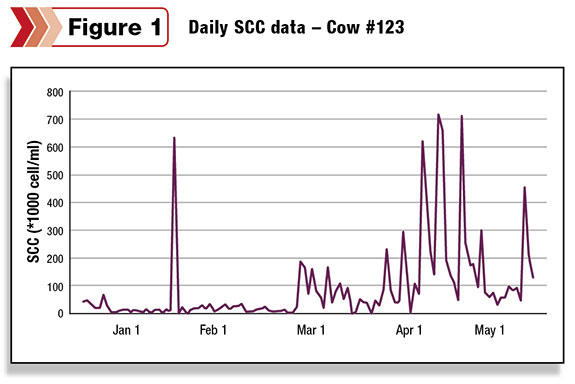Mastitis is among the most costly diseases of dairy cattle. It is a complex disease with many causes, many presentations and many treatment options. Prevention remains the most effective means of controlling this disease.
Prominent country-specific ( Canadian Bovine Mastitis and Milk Quality Research Network ) and international ( National Mastitis Council ) organizations have established programs producers and their veterinarians can adapt to their unique circumstance.
Discussion about changing the legal limit for cells per ml to 400,000 in the U.S. has prompted renewed discussion about how to treat cases of clinical mastitis and how to deal with subclinically infected cows with high SCCs, so-called “millionaires.”
There is no simple treatment decision algorithm for mastitis. A farm-specific targeted approach to treating mastitis must be developed with the herd veterinarian and implemented consistently by farm personnel.
The key components to the treatment plan include a clear and consistent definition for a case of mastitis, a rational approach to deciding which cows should be treated, an understanding of which bacteria are causing mastitis and a careful assessment of which treatments have the best outcomes.
Decide on a definition for a ‘case’ of mastitis
Clinical cases of mastitis are relatively easy to identify, provided someone is examining the milk, udder and cow at each milking. The use of a strip plate or cup is still one of the most effective ways to identify clinical cases in a timely manner.
Cases will vary from mild (visibly abnormal milk) to moderate (abnormal milk and heat or swelling in the udder) to severe (abnormal milk, inflamed udder and a sick cow) in presentation and are often the target of therapy.
A recent study published by Dr. Simon Dufour of the University of Montreal involving herds from Canada reported that most farms experience between 15 and 40 cases of mastitis per 100 cows per year. Half of these are mild, 38 percent are moderate, and only 12 percent are severe in nature.
Subclinical cases present a greater challenge and may be identified and defined on the basis of elevated SCC (monthly or daily), increased electrical conductivity (EC), elevated lactate dehydrogenase (LDH), differential SCC or the “old” tried and true California Mastitis Test (CMT). These cows may or may not require treatment.
The challenge we face in integrating the newer detection technologies into our case definition is that we aren’t comfortable in deciding which mastitis signals are important in identifying a mastitis episode that requires our intervention – and which ones are just passing indicators that the cow is responding to bacterial challenge in a normal way.

Figure 1 depicts the daily SCC for one cow. In mid-January we see a single dramatic spike in SCC from a baseline of 35,000 to more than 600,000 cells per ml, followed by a dramatic return to baseline within a day.
This represents a bacterial challenge to a quarter that stimulated a normal inflammatory response, which allowed the cow to overcome the challenge.
Clearly the cow did not require treatment intervention in this case.
About six weeks later, we see another rise in SCC, but this time the SCC remains mildly elevated for a period of time, shows significant daily fluctuations and generally remains elevated. This is typical of a challenge that the cow has more difficulty overcoming, and the cow might benefit from an intervention with intra-mammary antibiotic.
In both cases, whether we were monitoring mastitis using SCC, LDH or EC, there would have been an “alarm.” The challenge is deciding whether that alarm is indicative of the February episode or the March episode.
The only way to do that is to repeatedly check the cow and combine all of our information and knowledge to make the best decision.
In some cases the technology has a mathematical model (called a biomodel) to process all of the available cow information to make the best decision. In other cases, we have access to the raw data, and we must be the biomodel and make that decision.
Decide which cows to treat and which ones not to treat
Moderate to severe mastitis cases often require some degree of treatment (the herd veterinarian should provide guidance in developing treatment protocols), although antibiotics may not be included in every protocol.
Decisions about treating mild clinical and subclinical cases are more complex and should take into account the age of the cow, the stage of lactation, whether the case is a first case or a recurrent case, what the most likely “bug” is and how “valuable” the cow is to the herd.
Accurate herd and cow records are invaluable for this step in the process. It is generally most rewarding, both economically and functionally, to treat younger cows, earlier in lactation, that are experiencing a first case of mastitis.
Cows with high SCCs, the millionaires, present a new challenge. They become a focus when the herd or bulk tank SCC approaches the penalty limit.
Millionaires can often be found at the top of the “percent contribution” list on DHI reports or herd management computer software programs following a milk recording test. Unfortunately, these cows also fall into the two patterns illustrated in Figure 1.
Some have very short spikes, and the elevated bulk tank SCC may be a result of many of these short high spikes experienced by many cows. Identifying a cow to remove from the bulk tank in this instance is difficult, since it may be a different cow each day.
On the other hand, some cows will experience a slow but steady rise in SCC – and will stay high. These are typical of more chronic infections caused by contagious bacteria such as Staphylococcus aureus.
In this case, removing the cow or quarter from the bulk tank may be more effective in reducing the bulk tank SCC, especially in smaller herds. Antibiotic treatment of these millionaires is seldom effective.
In the first instance (with the short peaks), the cow is able to respond to the challenge without assistance, while in the second instance (with the slow but steady rise to a high SCC), the infection is so well established that antibiotic treatment during lactation is often not successful in producing a cure.
Decide which ‘bug’ is causing mastitis
On-farm culture-based systems to identify the bacteria or class of bacteria causing mastitis have long been advocated and discussed, although they work best on large commercial farms where the volume of cases allows farm staff to become proficient in using the system.
Culture of fresh milk samples by the herd veterinarian or a regional diagnostic laboratory offers higher-quality results; however, the delay in reporting those results to the farm makes it impractical as a guide for cow-specific treatment.
Polymerase chain reaction (PCR) techniques offer some advantages and disadvantages over culture-based systems and must be used and interpreted with caution.
Periodic culturing of frozen samples from a series of mastitis cases identified over time can help to establish a herd profile (a list of the bacteria most often associated with specific types of mastitis cases), which is then used to decide which bug is most likely to be causing the next case of mastitis.
This profile information becomes important in developing treatment protocols that are farm-specific and most likely to be successful.
Decide which drug works best
Many drugs, including antibiotics, are approved for the treatment of mastitis in lactating dairy cattle. There are some agents (bacteria and algae) not sensitive to these antibiotics.
Keeping track of the bacteria causing mastitis will help to guide the decision as to which treatments are best.
In addition, be sure to use drugs consistently and according to their label directions, following clearly described treatment protocols (developed in consultation with the herd veterinarian).
Be sure to record all treatments and treatment outcomes, both successes and failures. We generally do a poor job of recording which cows responded well to the first line of treatment and which ones did not. Periodically review the outcomes with the herd veterinarian to decide if a change in the protocol might be needed.
Mastitis treatment decisions are complex and often difficult. There is no single answer, no “silver bullet.”
Developing a plan that includes a consistent definition of mastitis on your farm, a process to decide which cows to treat, a profile of which bacteria are most commonly causing mastitis and a record of successes and failures for each treatment protocol should make the process just a little bit easier. PD
Kelton is with the University of Guelph’s Department of Population Medicine. He can be contacted by email .

David F. Kelton
Department of Population Medicine
University of Guelph






